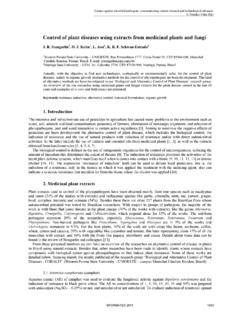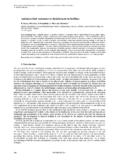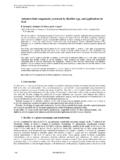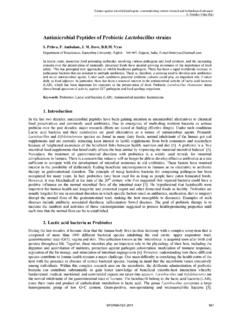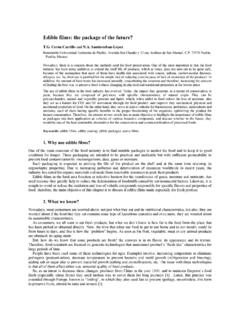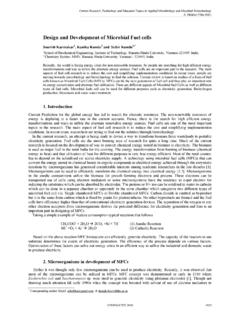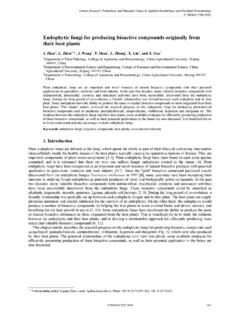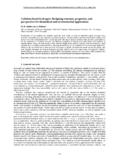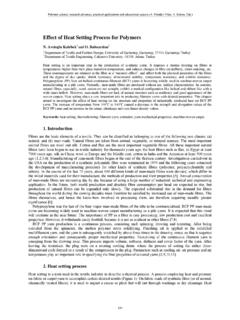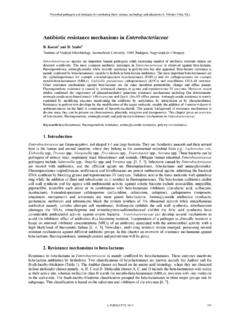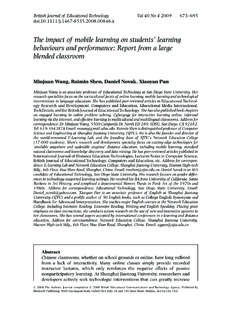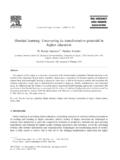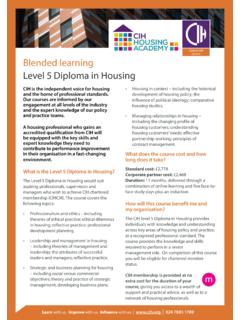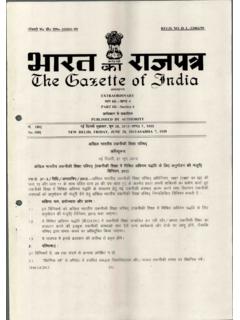Transcription of E-learning in Medical Education and Blended Learning …
1 E-learning in Medical Education and Blended Learning approach Dr. A. I. Albarrak Medical Informatics Unit, Department of Medical Education , College of Medicine, King Saud University,Riyadh, Saudi Arabia. Introduction Education has evolved from a material based process, where the instructor (teacher) focused on presenting information to students, to a student (learner) centered process where students are able to learn at their own pace. Furthermore, the student s role has changed from being a receiver to a being a learner and the instructor s role has changed to being a mentor, guiding students to acquire knowledge and improve their Learning skills [1]. The focus has shifted from a teacher-centered model to a learner-centered one, offering stronger Learning motivation and interactivity.
2 Interactivity maintains learner interest and provides a means for personalized Learning and reinforcement. Evidence suggests that E-learning is more efficient in most cases because learners gain knowledge, skills, and attitudes faster than through traditional instructor-based methods. This efficiency translates into improved motivation and performance. In addition, the use of E-learning is associated with improved retention rates and efficient use of content [2]. The main goals of Medical Education are to equip students and graduate clinicians with the necessary Medical knowledge and skills and to provide them with the strategies for their application in practice. The integration of E-learning into undergraduate, graduate and continuing Medical Education has a significant impact on the delivery and performance of Medical Education [3].
3 The rapid evolution and growth of information and communications technologies (ICT), and the rapidly changing health care environment with advances in the biomedical sciences and in the diagnoses and management of diseases, and the delivery of health care services, have led to the development of new services and applications. Furthermore, the shift towards competency-based Medical Education and problem based Learning , together with the increasing complexity and volume of Medical content, have increased the demand for continuing Education and knowledge updates. These have, in turn, created demands for new methods and approaches to Medical Education online continuing Medical Education (CME) and E-learning [3-5].
4 E-learning can be defined as the use of ICT or the Internet in educational activities. E-learning is also defined as Learning mediated by technology, such as the Intranet, and multi-media based computer applications. E-learning systems enable students to extend their Learning experiences beyond the borders of a classroom by using both online and offline Learning resources. Such activities usually increase the interaction among students and between instructors and students. Because of the nature of Medical Education , E-learning systems require specialist design to accommodate more practical sessions, and more student involvement in Medical procedures and operations. To provide Medical students with a productive E-learning experience, an E-learning system should be able to provide students, not only with access to text books and lecture materials, but with both simulated and real life cases including Medical history, lab results, radiology images and other patient related information.
5 These resources improve the students diagnosis and intervention skills, leverage their Learning outcomes and improve their Learning capabilities at the same time as improving their accessibility by utilizing ICT tools [6, 7]. History The use of computers in Medical Education has been in continuous development since the early 1960s. Its adoption however, has been limited by the programming process of entering data through punch cards and the limitations of relatively primitive computer languages. Although the earliest attempts to apply computer applications in Medical Education started in 1961, major developments in computer-assisted instruction occurred in quick succession in the late 1960s at several American Medical colleges.
6 Different terms such as computer-based Learning , computer assisted Education , computer assisted Learning ; CAL have been used but the differences were basically semantic. Ohio State University started a CAL application in 1967 as a one-terminal, one course system. In 1969 the program was incorporated into the evolving Independent Study Program in the basic Medical sciences and was called "TES" (Tutorial Evaluation System). Production of lessons was to a great extent assisted by the development of the COURSEWRITER III; a computer program that allowed an instructor to enter text in response to computer guidance without any need for programming skills. Simultaneously, the Massachusetts General Hospital Laboratory of Computer Science began developing simulations of clinical encounters.
7 Employing a computer language developed for the purpose and a well-designed instructional strategy, these simulations became highly sophisticated. By the middle of the 1970s, the 147 FORMATEX 2011 Education in a technological world: communicating current and emerging research and technological efforts A. M ndez-Vilas (Ed.)_____ Massachusetts General Hospital laboratory had developed more than 30 simulations with multiple cases within each simulation [8]. The University of Illinois developed a different type of simulation model that was termed CASE (Computer-Associated Simulation of the Clinical Encounter).
8 A common feature of these systems was that they ran on mainframe computers, accessible over telephone lines and with the capacity to time-share. The National Library of Medicine in 1972 sponsored a consortium to share these educational resources, paying the costs of access via a national computer network. The Massachusetts General Hospital, Ohio State University and the University of Illinois served as hosts. More than 150 institutions participated in this program. In 1984 an explosion of activity, that continues to date; was undoubtedly prompted by the advent of the personal computer [8]. Modes of E-learning There are many approaches to implementing E-learning systems including distance Learning which enables students in different continents to obtain graduate and post graduate degrees remotely with no need to attend lectures in person [9].
9 Creating E-learning material involves several components. Once content is developed, it must be managed, delivered, and standardized. Content comprises all instructional material structured in a meaningful way. Material could be linked to a specific Learning objective as a part of a specified curriculum. Examples of the instructional materials include tutorials, PowerPoint presentation slides of lectures, case-based Learning , hypermedia, and web links. Content management includes all the administrative functions ( storing, indexing, and cataloging) needed to make E-learning content available to learners. Examples include portals, repositories, digital libraries, Learning management systems, search engines, and e-portfolios [10-12].
10 Content delivery may be either synchronous or asynchronous. Synchronous delivery refers to real-time, where all learners receive information and communicate simultaneously. Examples include teleconferencing or videoconferencing, Internet chat forums, and instant messaging. While in asynchronous delivery, the transmission and receipt of information do not occur simultaneously, the learners are responsible for pacing their own self-instruction and Learning [13, 14]. A concept related to E-learning prior to the birth of the Internet was multimedia. Multimedia uses two or more media, such as text, graphics, animation, audio, and video to produce engaging content delivered by computer. A detailed definition of multimedia is the combination of various digital media types, such as text, images, sound and video, into an integrated multi-sensory interactive application or presentation to convey a message or information to an audience [15].
